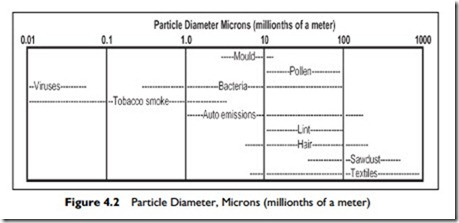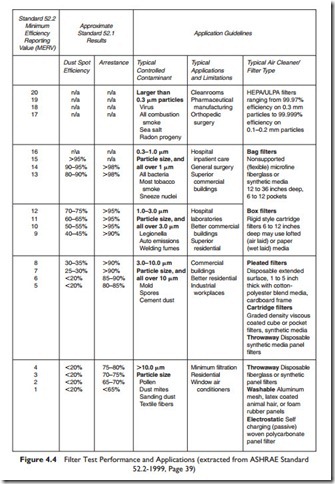Controlling Indoor Air Quality
Maintaining acceptable IAQ depends on the judicious use of three methods: Source control
Filtration
Dilution
Source Control
The most important method of maintaining acceptable indoor air quality is by controlling sources of contaminants and pollutants. Sources can be controlled by restricting their access to the space, either by design or by appropriate maintenance procedures, and by exhausting pollutants that are generated within the space. Avoiding the use of volatile solvents and banning smoking are two simple indoor examples.
Another example of source control is found in a new requirement in Standard 62.1-2004 where it states that water for humidifiers “shall originate directly from a potable source or from a source with equal or better water quality.” In the past, steam from the steam heating system was often used for humidification of buildings. This steam was frequently treated with anti- corrosion additives that would not be acceptable in potable water. Now, this steam is not an acceptable source for direct humidification.
When designing the air intake system, one should always deliberately reduce the likelihood of pollutants coming in from outside. Methods include locating intakes:
Away from the ground, where dust blows by
Away from loading docks, where there are higher concentrations of pollutants from vehicles Away from outlets on the roof that vent things, such as toilets, furnaces, drains, and fume hoods One common source of indoor pollution is mold. The spores and dead particles of mold adversely affect many people. To prevent mold, keep the building fabric and contents reasonably dry. As a general rule, maintain the relative humidity below 60% to prevent mold growth. This is a challenge in a hot, humid climate with air-conditioned buildings where the outside air contains so much moisture. For example, a new prestigious hotel in Hawaii had to be closed within a year of opening, due to mold in over 400 bedrooms. Remedial costs will exceed $US10 million.
One source of mold, that is often neglected, is the drain pan beneath a cooling coil. The coil collects moisture and, being wet, some dirt out of the air. Ideally, this moisture and dirt drips down into the tray and drains away. Unfortunately, (and frequently), if the tray has a slope-to-drain ratio that is less than the required 1/8 inch per foot, a layer of sludge can form in the tray and grow mold. If the coil is not used for cooling for a while, the tray dries out and the crust of dried sludge can breakup and get carried through the system into the occupied spaces. Regular cleaning of the tray is required to minimize the problem.
If the pollution is from a specific source indoors, then direct exhaust can be used to control the pollutants. For example: the hood over a cooking range pulls fumes directly from the stove and exhausts them; exhausting the fumes from large photocopiers avoids contaminating the surrounding office space; and the laboratory fume cabinet draws chemical fumes directly to outside. When designing any direct exhaust system, one should attempt to collect the pollutant before it mixes with much room air. This reduces the required exhaust air volume and hence reduces the amount of conditioned air required to make up for the exhaust.
The design of exhaust systems for a large variety of situations is very clearly explained and accompanied with explanatory diagrams in Industrial Ventilation3, published by the American Conference of Governmental Industrial Hygienists.
Filtration
Filtration is the removal of contaminants from the air. Both particulate (particles of all sizes) and gaseous contaminants can be removed, but since gaseous filtration is a rather specialized subject, we will not discuss it in this course.
Particulate filters work by having the particles trapped by, or adhere to, the filter medium. The actual performance of a filter depends on several factors, including particle size, air velocity through the filter medium, filter material and density, and dirt buildup on the filter. The main operating characteristics used to distinguish between filters are:
Efficiency in removing dust particles of varying sizes Resistance to airflow Dust-holding capacity (weight per filter)
Choosing a filter is a matter of balancing requirements against initial purchase cost, operating cost and effectiveness. In general, both the initial cost and the operating cost of the filter will be affected by the size of the particles that need to be filtered out, and the required efficiency of the filter: the smaller the particle size and the greater the efficiency required, the more expensive the filter costs.
The Figure 4.2 shows a sample of particles and their range of size.
Information on filter performance is usually based on a standard. For the HVAC industry, ASHRAE has produced two standards. The first was ASHRAE Standard 52.1-1992 Gravimetric and Dust Spot Procedures for Testing Air Cleaning Devices used in General Ventilation for Removing Particulate Matter4 (Standard 52.1). Testing a filter to Standard 52.1 produces an “ASHRAE atmospheric dust spot efficiency” and an “ASHRAE arrestance.” The “dust spot” efficiency is a measure of how well the filter removes the finer particles that cause staining, and the “arrestance” is a measure of the weight of dust that is collected before the resistance of the filter rises excessively. Unfortunately, the dust spot effi- ciency does not give much information about filter performance for different particle sizes and does not differentiate among less efficient filters.
As a result, a new standard was introduced, ASHRAE 52.2-1999 Method for Testing General Ventilation Air-Cleaning Devices for the Removal Efficiency by Particle Size5. It is based on using a particle counter to count the number of particles in twelve different size fractions. This data is used to classify a filter into one of 20 “Minimum Efficiency Reporting Values” called MERV. The least efficient filter is MERV 1 and the most efficient, MERV 20. Figure 4.3 shows typical filters with their range of performance and typical applications.
There are numerous types of filters, made with a variety of filter media. The simplest, cheapest, and generally least effective, is the panel filter. The panel filter, commonly used in residential systems, is a pad of filter media across the air stream. The pad can be aluminum mesh, to provide a robust washable unit, typically having a MERV rating 1 to 3. The media may be a bonded fiberglass cloth with a MERV rating up to 4. There are many other constructions that are designed to satisfy the market at an affordable price.
The performance of the panel filter can be improved by mounting panel filters at an angle to the air stream to form an extended surface. For the same air velocity through the duct, the filter area is increased and the velocity through the media is decreased to improve performance.
The filtering performance and dust holding capacity can be further improved by pleating the media. Variations of pleated media filters cover the MERV range from 5 to 8.
To achieve a higher dust holding capacity, the media can be reinforced and formed into bags of up to 36 inches deep. The bags are kept inflated by the flow of air through them during system operation.
These arrangements are shown diagrammatically in Figure 4.3.
Two of the factors that influence filter performance are the filter media and the air velocity through the media. Some filters have graded media with a coarse first layer to collect most of the large particles, and then one or more finer layers to catch progressively smaller particles. As a result of the grading, the final fine layer does not get quickly clogged with large particles. Pleated and bag filters extend the surface of the filter. This reduces the velocity of the air through the fabric and greatly increases the collection area for the particles, resulting in a much higher dust-holding capacity.
For ventilation systems, filters with a MERV above 8 are almost always provided with a pre-filter of MERV 4 or less to catch the large particles, lint and insects. It is more economical to remove the large particles with a course filter and prolong the life of the better filter.
Electronic filters can be used as an alternative to the media filters discussed above. In an electronic filter, the air passes through an array of wires. The wires are maintained at a high voltage, which generates an electrical charge on the dust particles. The air then passes on between a set of flat plates that alternate between high voltage and low voltage. The charged dust particles are attracted to the plates and adhere to them. These filters can be very efficient but they require cleaning very frequently to maintain their performance. Larger systems often include automatic wash systems to maintain the performance.
Filter Characteristics
Let us return to the three main filter characteristics:
Efficiency in removing dust particles of varying sizes Resistance to airflow
Dust-holding capacity
Efficiency in removing dust particles of varying sizes is influenced by how clean the space is required to be, and whether any particular particles are an issue. Thus one might choose a MERV 5 to 8 filter in an ordinary office building, but a MERV 11 to 13 filter in a prestige office complex. The higher MERV filters cost more to install and to operate but they reduce dirt in the building and so they save on cleaning and redecorating costs.
When it comes to medical facilities, MERV 14 to 16 filters will remove most bacteria and can be used for most patient spaces. For removal of all bacteria and viruses, a MERV 17, called a HEPA filter, is the standard filter. HEPA filters have an efficiency of 99.7% against 0.3 micron particles.
Resistance to airflow directly affects the fan horsepower required to drive the air through the filter. Many less expensive, pre-packaged systems do not have fans that are capable of developing the pressure to drive air through the dense filter material of the higher MERV rated filters. Typically, most domestic systems will handle the pressure drop of a MERV 5 or 6 filter, but not higher.
Dust-holding capacity influences the filter life between replacements. A pleated filter with MERV 7 or 8 may be all that is required, but a bag filter with MERV 9 or 10 can have a much higher dust holding capacity. The bag filter could, therefore, be a better choice in a very dirty environment or where there is a high cost to shut down the system and change the filters.
Dilution
In most places the outside air is relatively free of pollutants, other than large dust particles, birds, and insects. When this air is brought into a space, through a screen and filter to remove the coarse contaminants, it can be used to dilute any contaminants in the space. We also need a small supply of out- side air to provide us with oxygen to breathe and to dilute the carbon dioxide we exhale. Dilution ventilation is the standard method of controlling general pollutants in buildings and the methods and quantities required are detailed in Standard 62.1-2004, which is the subject of the next section, 4.5.


